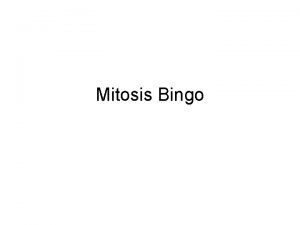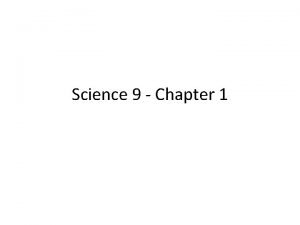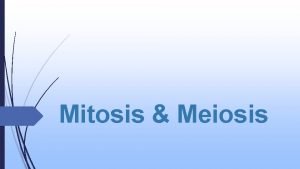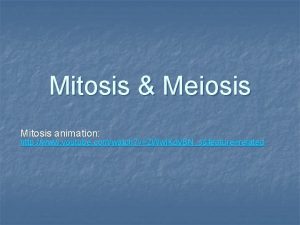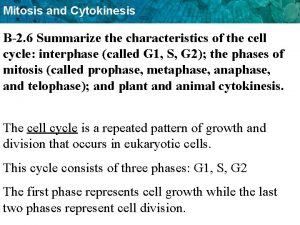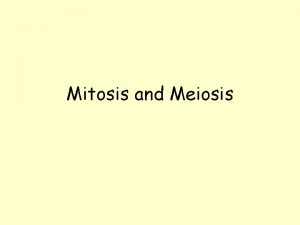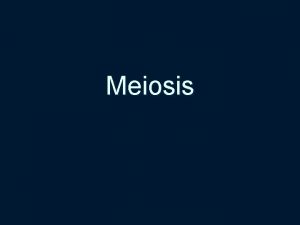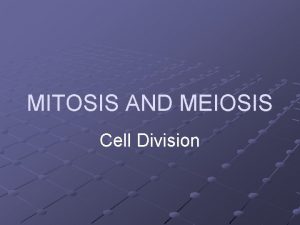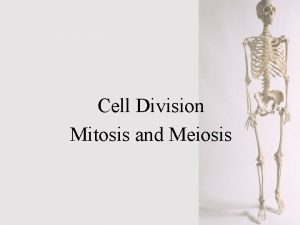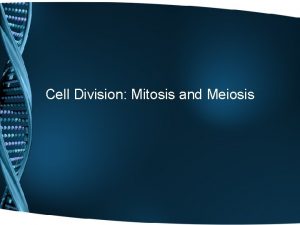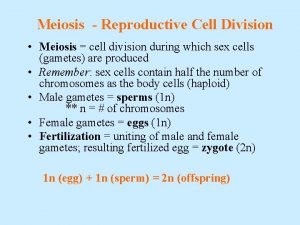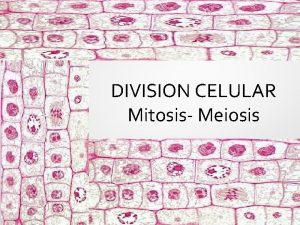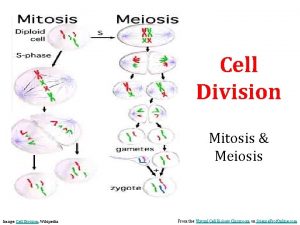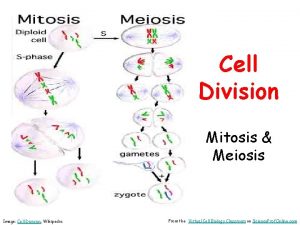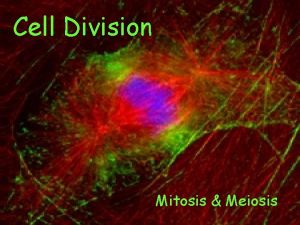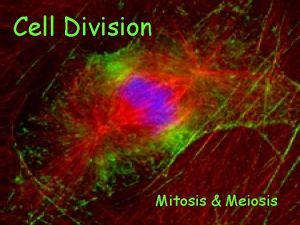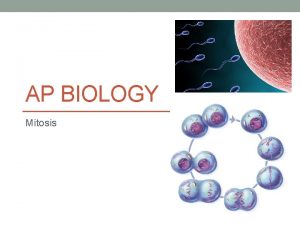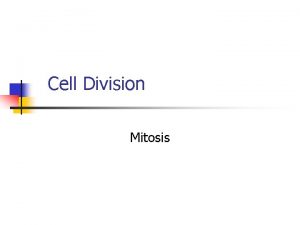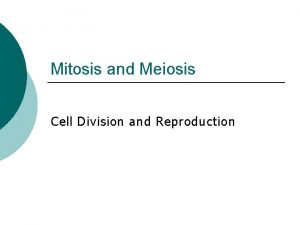Mitosis and Meiosis Mitosis Cell Division n In


















- Slides: 18

Mitosis and Meiosis

Mitosis: Cell Division n In each human cell there are 23 unique chromosomes each containing thousands of genes. Most cells in the human body have 2 copies of every chromosome These cells are called diploid (2 n).

Mitosis n In order to keep the same genetic information cells undergo a process of division that ensures the same information is passed from parent to offspring.

A) Cell Cycle

A) Cell Cycle n The life cycle of a cell has 2 portions: Interphase and Mitosis. ¡ Interphase is the normal condition of a cell. During this time the cell does its job and prepares for division. ¡ Mitosis is the process of division.

A) Cell Cycle n Interphase has 3 steps: ¡ ¡ ¡ G 1 - The cell produces proteins and performs its normal functions in the body. S – DNA inside the nucleus replicates. G 2 – The cell resumes growth/function and readies for division.

B) Mitosis n Mitosis is divided into 4 steps: ¡ ¡ n Prophase Metaphase Anaphase Telophase After Mitosis Cytokinesis occurs, which is the division of the cytoplasm.

Mitosis: Prophase n n n The nuclear envelop breaks down Chromatin condenses into chromosomes (Xs) Spindle fibers begin migrating to opposite ends.

Mitosis: Metaphase n n The individual chromosomes line up at the center metaphase plate Centrioles and spindles are at opposite ends of the cell and connected to every pair of chromosomes at the centromere.

B) Mitosis: Anaphase n The centrioles pull on the spindles and separate the chromatids to opposite sides.

B) Mitosis: Telophase n n n The chromatids are now in opposite ends of the cell and they begin to decondense. Nuclear membrane begins to reform. Spindles break down.

B) Mitosis: Cytokinesis n In animals proteins pinch off the center of the cell into 2 each parts, seperating the cytoplasm. n. In plants the Golgi synthesizes a new cell wall along the metaphase plate, creating 2 separate cells.

C) Meiosis n n n In sex cells cell division is different. The process must half the number of chomosomes in each cell. This allows for fertilization to recreate the complete number of chromosomes.

C) Meiosis n n The process of meiosis is called a reduction division. There are 2 rounds of division with some slight differences.

C) Meiosis

C) Meiosis n The first round of meiosis has the following steps: Prophase I, Metaphase I, Anaphase I, and Telophase I. n The second round of division is made up of: Prophase 2, Metaphase II, Anaphase 2, and Telophase 2.

C) Meiosis n Differences: ¡ ¡ ¡ During Prophase I homologous chromosomes pair up at the metaphase plate! There is NO DNA duplication between Meiosis I and II, so the DNA never has a chance to double. The end result is 4 haploid cells instead of 2 diploid cells.

C) Meiosis
 Mitosis meiosis
Mitosis meiosis Cell division mitosis and meiosis
Cell division mitosis and meiosis Mitosis concept map
Mitosis concept map Mitosis bingo
Mitosis bingo Section 10-2 cell division
Section 10-2 cell division Cell cycle and cell division
Cell cycle and cell division Cell cycle mitosis
Cell cycle mitosis Plant and animal reproduction venn diagram
Plant and animal reproduction venn diagram Stages of mitosis and meiosis
Stages of mitosis and meiosis Crossing over occurs during
Crossing over occurs during What is the difference between mitosis and meiosis 2
What is the difference between mitosis and meiosis 2 Study guide chapter 10 section 1 meiosis
Study guide chapter 10 section 1 meiosis Chapter 10 section 1 meiosis
Chapter 10 section 1 meiosis Write difference between mitosis and meiosis
Write difference between mitosis and meiosis Kesler science atoms answer key
Kesler science atoms answer key Haploid vs diploid venn diagram
Haploid vs diploid venn diagram Mitosis meiosis animation
Mitosis meiosis animation Summarize mitosis
Summarize mitosis What is diploid and haploid
What is diploid and haploid



